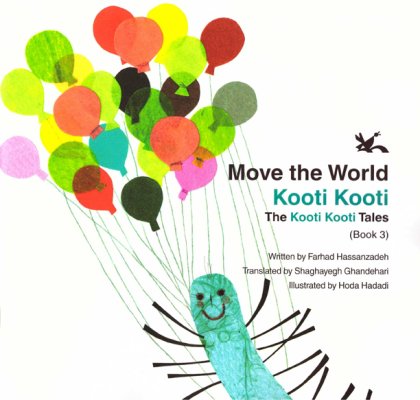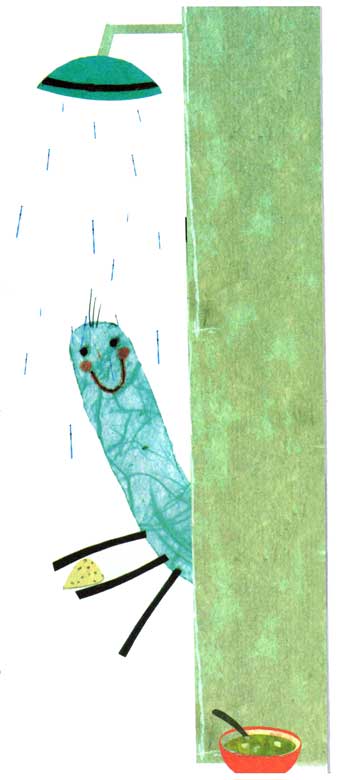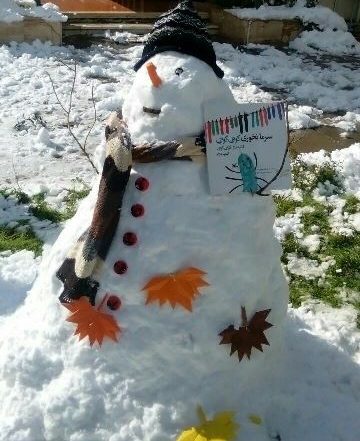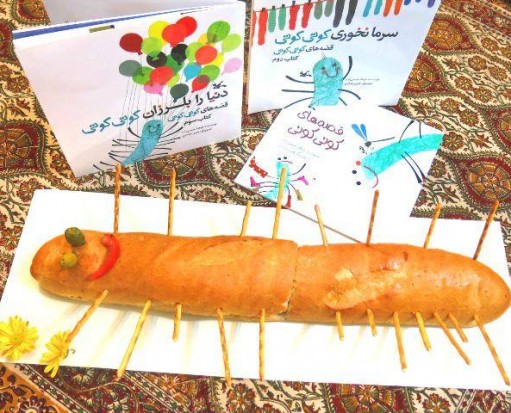kooti Kooti Watch out You Don’t Catch a Cold {The kooti Kooti Tales (Book2)}
◊Farhad Hassanzadeh
◊Translated in English by Shaghayegh ghandehari,
◊Hoda Haddadi (illustrator)
◊Tehran: Kanoon. (Institute for the Intellectual & Cultural Development of Children and Young Adults) (2016)
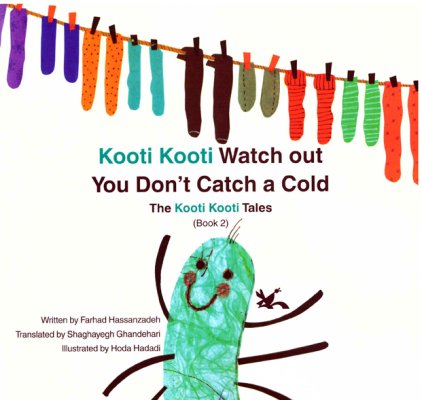
kooti Kooti Watch out You Don’t Catch a Cold
Imagine that you have a thousand feet instead of two. When you put your first foot through a doorway, how long would it take for your last foot to go through the same doorway? What would you do on a football field, in a bathtub, etc.? The main character of Koo Koo stories is a millipede with a thousand feet who faces a thousand problems, and when he cannot solve the problems, he cries cupfuls of tears. Kooti Kooti
When Koo Koo sees that a few of the neighbors have shoes, he asks his father to buy shoes for him. However, since Father does not have much money, he does as Mother suggests: each month he buys one pair of shoes for Koo Koo. Finally, aer a few years, he has various types of shoes for all his feet, but now the pair he got in the first month has become too ght for him. When Koo Koo plays football, he steps over everyone’s feet. When Koo Koo plays football, he steps over everyone’s feet. When he takes a bath, scrubbing the soles of his feet takes a whole day. Nobody is willing to play Atal Matal Tootooleh (a game in which counng the players’ legs is essenal) because it is very difficult to .
count his legs. Koo Koo’s adventures are humorous, and while they bring the child joy and laughter, they strengthen the spirit of quesoning and cricizing in the young reader. When one of Koo Koo’s shoes gets torn, he wails and whines, but upon seeing a small worm who neither has legs nor shoes and yet crawls laughingly as he goes to school, Koo Koo stops complaining. Some of the stories in the series are metaphorical and not only Koo Koo but the child audience are induced to think. More importantly, they help the child understand metaphors because metaphors are formed in the acons of Koo Koo.
Like every other child, Koo Koo likes to play truant every now and again. So he moans and groans. His 55th foot is hurng. Pain shoots up his 220th foot. His 333rd foot is itching badly. His 442nd foot is swollen. His 678th foot… oh, no, it has caught a chill… and pung on an act, he grumbles. The young reader’s emoonal intelligence is empowered along with The young reader’s emoonal intelligence is empowered along with Koo Koo’s because with Koo Koo, they experience their own inner needs as well as those of others and also experience how to interact with others. Koo Koo represents a young child whose parents do not understand his problem because they do not do what he does, like wearing shoes and trousers. Koo Koo does not want to be like his parents. He does not even want to be like Mrs. Fly, who tries on shoes once and then throws them away. He wants to be himself, so he embraces the problems wholeheartedly: because he loves shoes… because he loves trousers… he loves washing socks… he loves washing socks… More importantly, the child easily understands metaphors in Koo Koo’s adventures. In the Iranian children’s book market, Koo Koo is one of the few comic works wrien for preschoolers. We know that there are few comic books, especially for young children, but Koo Koo’s humor is sweet and charming even for very young children. The book illustraon has invigorated the characterizaon of Koo The book illustraon has invigorated the characterizaon of Koo Koo, Mother, Father, Grandfather, and Grandmother. And it is inspiring for those youngsters who work on such arsc books. Koo Koo is fit for 4-10 year-old children. 4-7 year-old children who are incapable of metaphor comprehension but are metaphor makers can become familiar with metaphors through Koo Koo’s acons. 7-10 year old children who understand metaphors, but cannot make them are encouraged to create metaphors. The Instute for the Intellectual Development of Children and Young Adults (Kanoon), the publisher of the three-volume Koo Koo series, has published the first volume in Kurdish, English, Mandarin, and Malay as well.


